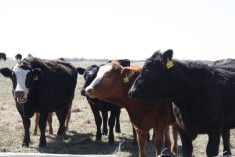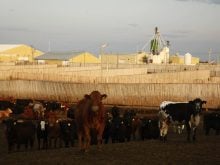This cattle market information is selected from the weekly report from Canfax, a division of the Canadian Cattlemen’s Association. More market information, analysis and statistics are available by becoming a Canfax subscriber by calling 403-275-5110 or at www.canfax.ca.
Fed market steady
Sales volumes were too light to establish a weighted average steer or heifer price, but the market tone was steady.
Dressed bids and sales were reported from $276-$278 per hundredweight delivered.
Read Also

Flax sector sees omega-3 opportunity
SASKATOON — A global shortage of omega-3 oils could be an opportunity for the flax sector, says an industry official….
Many producers are holding back cattle hoping for a spring rally.
Slow slaughter rates are backing up cattle. March contract cattle were pushed into April.
Interest in the cash market has been mixed with limited local competition. Alberta plants have different inventory. One plant has scheduled cattle for two week delivery over the past two weeks, while the other is mostly looking for May cattle.
A few western Canadian fed cattle traded to the United States with prices working back to the mid-$160s on a live basis.
More heifers were slaughtered than steers, which is common this time of year.
Weekly exports were about 8,000 head, the most since November 2014.
Producers are on the tail end of their yearlings, and fed calf volumes will remain light over the next 30 days.
Dressed sales in the northern United States were US$212-$216 per cwt., while live sales in the south were $132-$136.
Fed supplies in the north are tight, and there is talk that cattle in the south are being shipped into Nebraska.
Slaughter cows mixed
D1, D2 ranged C$95-$108 to average $101.60, which is steady with the previous week. D3s ranged $80-$97 to average $88.13, down $2.25.
Rail grade cow prices rose to $197-$202 delivered. Butcher bulls rose $1.32 to $129.92.
Weekly western slaughter to April 2 fell nine percent to 5,414 head.
Weekly exports to March 26 were steady at 4,914 head.
Feeders lower
Feeder steers were down $5.12, and heifers fell $7.79 from the previous week
Steers 500-600 pounds have fallen for six consecutive weeks, and average prices are more than $34 per cwt. lower than the last week of February. Thin profit margins and dry weather have weakened interest in buying grass cattle.
Backgrounding losses have renewed interest in retained ownership to finish feeders through to slaughter. However, total auction volumes for the week were large at 26,528 head, up 69 percent from the same week last year.
The auction volume is down two percent this year at 358,106 head.
Feeder exports typically surge in March, and this year it rose to 12,791 head in the week ending March 26. However, that was still down 29 percent from last year at the same time.
Exports are down 62 percent for the year.
Some auction marketings have been deferred, but volume in coming weeks should moderate following the seasonal trend.
Bred cows ranged $1,600-$2,700, bred heifers were $1,800-$2,650 and cow-calf pairs were $2,00-3,200.
US beef lower
Choice cutout was US$214.74, per cwt. down $6.25, and Select was $205.91, down $4.57.
The lower prices encouraged better movement, which was the largest since November 2015. It put packers in a better inventory position.
Beef demand should improve as the weather warms and buyers procure for the May market.
Weekly Canadian cutout values to March 26 saw AAA at C$292.20, down $3.99, and AA was $284.91, down $1.38.














